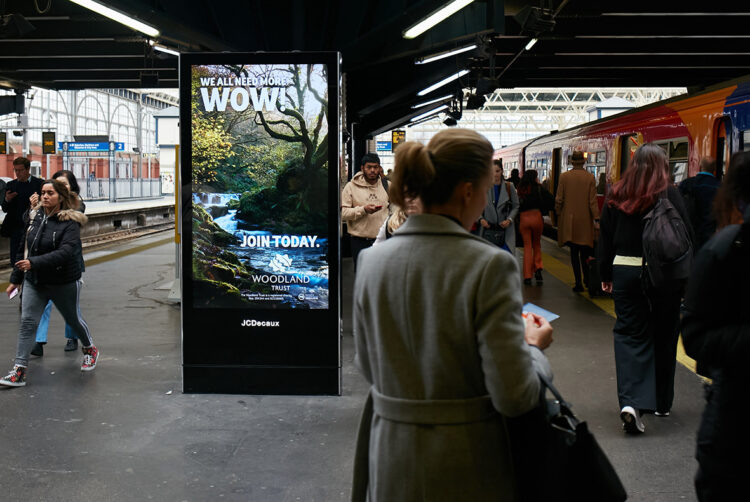A rallying cry for more creativity in programmatic DOOH

Partner Content
The creative potential of programmatic digital OOH is vast. JCDecaux explains how brands can best utilise pDOOH creativity and what benefits it can bring.
OOH advertising provides brands with a versatile creative canvas that can be used to amaze and delight large audiences in a variety of ways in premium locations.
From large-scale installations to 3D and anamorphic designs to interactive screens — the creative potential of OOH is vast. Meanwhile, programmatic capabilities enable brands to display digital OOH (DOOH) ads to targeted, data-defined audiences during specific moments.
However, it frustrates me that, in many cases, the selection of a programmatic route to market does not maximise the creative and dynamic potential in the creative. That simply doesn’t have to be the case — programmatic digital OOH (pDOOH) offers brands a multitude of creative opportunities that deliver wide-reaching benefits.
Programmatic doesn’t equal robotic
Notably, pDOOH is a one-to-many channel, not a one-to-one channel. Data-driven audience discovery results in compelling, aggregated real-world insights into consumers.
Who they are, where they spend their time, how and when they move between different locations, how they behave, what motivates them… These insights, integrated into a demand-side platform (DSP) or trading desk, enable media buyers to allocate budgets for optimal cost efficiency and optimise campaigns in real time using intelligent technology.
But what about creative? In an online scenario, personalisation is often achieved through adding technology solutions that create thousands of combinations of assets, supposedly tailored to individuals. This often leads to creative focused on appealing to rational motivations.
In pDOOH, we are trying to increase relevance for a wider but targeted audience. We are trying to grab attention and reach out to the heart, but dynamic variables can also heighten the rational response.
What does the creative process look like in pDOOH?
First of all, you need to identify the key data points (or triggers) that create opportunities for creativity. These signals could come from a brand’s first-party data, eg. product sales data by location, product availability, price versus competition or social sentiment.
We can also use real-time data and triggers from APIs, eg. weather, traffic levels, news and current affairs, and sport scores. Once you have a clear view of the data signals you will use and how you can best adapt creative to best meet consumer needs and match their motivations in each scenario, you need to test the resulting ads.
Solutions such as VIM, JCDecaux’s AI-driven creative testing tool, or System1, provide you with predictive analysis of how likely your ads are to attract consumers’ attention and therefore generate the desired outcome. These insights can be used to create final versions of each iteration of your ad, ready for testing in the real world.
Working with a specialist in dynamic creative optimisation (DCO) and your media owner partners ensures that scientific methodologies are applied to your creative testing and optimisation, and that the results you see are statistically significant. You can expect granular creative insights and analysis, and real-time optimisation based on your campaign goals.
Creativity doesn’t look the same for all brands
Consistent and controlled: For established, scaled brands, creativity often revolves around consistency and flexibility. Personalisation is likely to be based on geographic area, especially for brands with physical locations.
For brands selling more expensive products, eg. automotive manufacturers and luxury retailers, there may be a longer-than-average purchase cycle that requires consistent, controlled, effective creative that speaks to the needs and motivations of specific audiences.
In these scenarios, the number of creative variations per market may be relatively small and success should be measured using brand-uplift metrics.
Real-time updates: Travel, hospitality, retail and service industry brands’ advertising and sales performance are highly sensitive to even small changes in price, availability and other consumer trends. Additionally, these brands often have a relatively wide target audience. This presents a challenge when it comes to showing consumers the right ad based on their location and demographics.
Integrating relevant data feeds into your DSP or ad server — eg. price or Google Maps footfall data — enables brands to update creative in real time to show the most popular or competitive product in a specific area, or show up-to-date availability, or simply reach consumers only during times when footfall to your store is low.
With this type of DCO, you may expect a high number of dynamic variations. However, due to the immediacy of consumer action, measurement can be more akin to online channels, eg. cost per sale and return on investment.
Motivation-based: Consumers buy the same products for different reasons, especially in the FMCG space. For example, one person might buy a moisturiser because of a particular skin condition, whereas others may be more motivated by nature-inspired fragrances.
For pDOOH buyers, this represents an opportunity to test multiple creative variations across different audiences based on demographics, affinities, precise skin-need states and climate triggers. Robust multivariate testing enables marketers to deduce how to most effectively deliver the right product mix and drive awareness of key product proof points that would resonate for each of their target sub-segments.
Once again, this type of DCO will result in a high number of creative variations and requires integration of sales data into the measurement process to evaluate effectiveness.
Why brands should get more creative in pDOOH
There are many benefits to being more creative in pDOOH.
First, more thoughtful data-driven creative results in performance uplifts across brand and direct-response metrics. Secondly, once you’re familiar with the process of generating data-driven DCO strategies, campaigns can be up and running very quickly, enabling you to react to consumer or external trends and increase contextual relevancy, thus boosting performance further — without the need to redesign and re-traffic creative.
Data from a collaborative study by Neuro-Insight, JCDecaux, Clear Channel and Posterscope showed that adapting creative to the local environment appeals to changing mindsets and increases overall effectiveness by 17%. Furthermore, showing relevant content within creative increases engagement by 18%, showing relevant content at a relevant moment delivers a 32% lift in ad recall and an average increase of 16% in sales.
Creating the right templates can have hugely beneficial results in your ability to deploy tailored, relevant ads, along with the opportunity to effectively measure the impact. For cross-border campaigns, we have noted that production costs are more effective and efficient. Finally, doing more with your creative generates additional insights that can be fed back into future creative development across all channels.
Read part one of this series
The importance of understanding media quality in programmatic DOOH
Read part three:
Targeting and measurement improvements put pDOOH on par with other digital channels
 Mark Halliday is director of programmatic at JCDecaux UK
Mark Halliday is director of programmatic at JCDecaux UK




